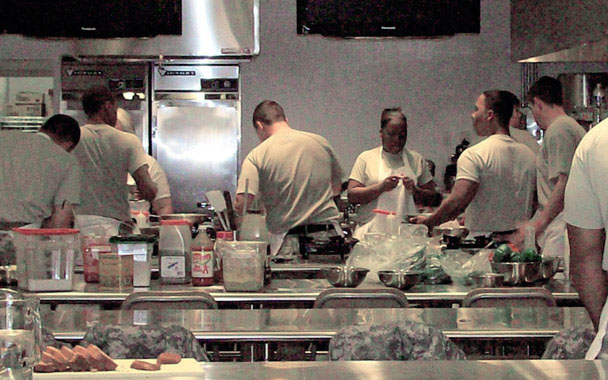On a late morning in May, Susan Watterson, dressed in chef’s whites, stands behind a stove facing eight soldiers in boots and camouflage. “Who here likes salmon?” she asks.
“I’ll only eat fish if it’s deep-fried,” replies a young specialist, Ruthie Gardner, the only woman in the group.
Watterson isn’t doling out standard-issue kitchen mess; she’s the chef and one of the principals of CulinAerie, a relatively new cooking school in Washington, D.C., and she’s leading the final day of a two-week boot camp for Army cooks from a Special Forces unit based in Fort Bragg, North Carolina. Before being deployed to Afghanistan for a six- to twelve-month stint making meals for 600 to 800 soldiers at a time, these enlistees—ranging in age from 22 to 40—wanted to hone their cooking skills. So for the past two weeks they’ve arrived here every morning for a half-day of classes. Each day is organized around a single ingredient: eggs, poultry, or grains, for example. Sprinkled throughout the course are field trips to Eastern Market or the White House.
Traditionally, the Army doesn’t outsource food-service training. But Army cooks only have one cooking school available to them—the Quartermaster Center and School, based in Ft. Lee, Virginia—and it offers a choice of just two courses: Basic Skills Training (also known as IET), during which they learn culinary and baking skills for ten hours a day over the course of eight weeks; and Advanced Culinary Skills Training Course (ACSTC), which emphasizes knife skills, menu development, buffet platter production, table service, and purchasing. While Quartermaster courses provide basic culinary training, career cooks such as this crew found themselves hungry for a deeper understanding of ingredients, flavor dynamics, and cooking techniques that their classes hadn’t had time to cover.
Staff Sergeant Hunter Blankenship, a Floridian with wire-rimmed glasses and a fondness for Texas Pete, took the initiative in setting up the civilian course—he just couldn’t take the monotony coming out of his kitchen, no matter how much hot sauce he used. Master Sergeant Arthur Vernon, the senior enlisted soldier in the group, agreed that an outside cooking course would be worth it because “cooks lose their edge” from serving so many heat-and-eat dishes and MREs (Meals Ready to Eat, the individually packaged field rations given to soldiers). “We wanted to be more inspired and creative,” he says. “It was difficult to convince the Army that a civilian cooking school was good for our unit, since it’s expensive and somewhat of an experiment,” but he argued that improved skills would cut down on waste, saving the Army money. His request was funded. As far as he knows, his group is among the first cooks at Fort Bragg and elsewhere to formally train among civilians.
Stretching ingredients is especially important because of the Army’s sourcing requirements: While civilian chefs are free to purchase food according to culinary interest, budget, and consumer demand, Army cooks must buy all provisions from the Army Supply Corp., which means few fresh herbs (let alone fresh catch) and cornstarch instead of cream. And the juice—don’t get them started. “What do you use for juice?” asks Watterson, formerly a managing director of L’Academie de Cuisine in Maryland and a cook at D.C.’s Obelisk. “We poke a hole in hundreds of juice boxes when we have to,” says Gardner. Unlike Watterson’s fresh salmon, these cooks’ fish would come vacuum packed with a side of boil-in-bag sauce. But Watterson, who designed the syllabus with Blankenship’s input, is teaching flavor pairings and techniques—including smoking, steaming in parchment paper, and slow cooking—that will elevate the ingredients available to Army cooks.
Blankenship lights up as he watches Watterson make salmon cakes and explain the breadcrumb-to-fish ratio. As she shapes each one in a round cookie cutter, he raises his hand. “A little Texas Pete would send that off just right,” he says. “Go ahead and add some,” Watterson replies, jokingly resigned. “Yes Sir, Miss Susan,” he says.
“I have no idea what I’m doing yet,” Blankenship tells me as he douses his salmon cake with hot sauce, “but this is really good.”
Gardner is having a little more trouble finding inspiration, despite Watterson’s recipe demonstrations and suggestions (including salmon hobo packs with corn, black beans, red pepper, and lime; smoked salmon, made on the stove using wood chips, jasmine tea, sugar, and salt; or seared salmon dressed with a lemon caper sauce).
“What’s a caper?” Gardner asks, reaching for the jar to smell the contents. “It’s a berry,” says Watterson, “And it’s pickled. It’s not really something you would eat alone, but it adds interest to the sauce.” Gardner plucks one, places it on her tongue, and makes a face. “Great, Ruthie will never trust me again,” Watterson laments.
But it’s not true. “We like this class because it’s so small,” says Gardner. “We get so much one-on-one time.”
The cooks and the rest of their battalion were deployed to Afghanistan in June.



 Pinterest
Pinterest


